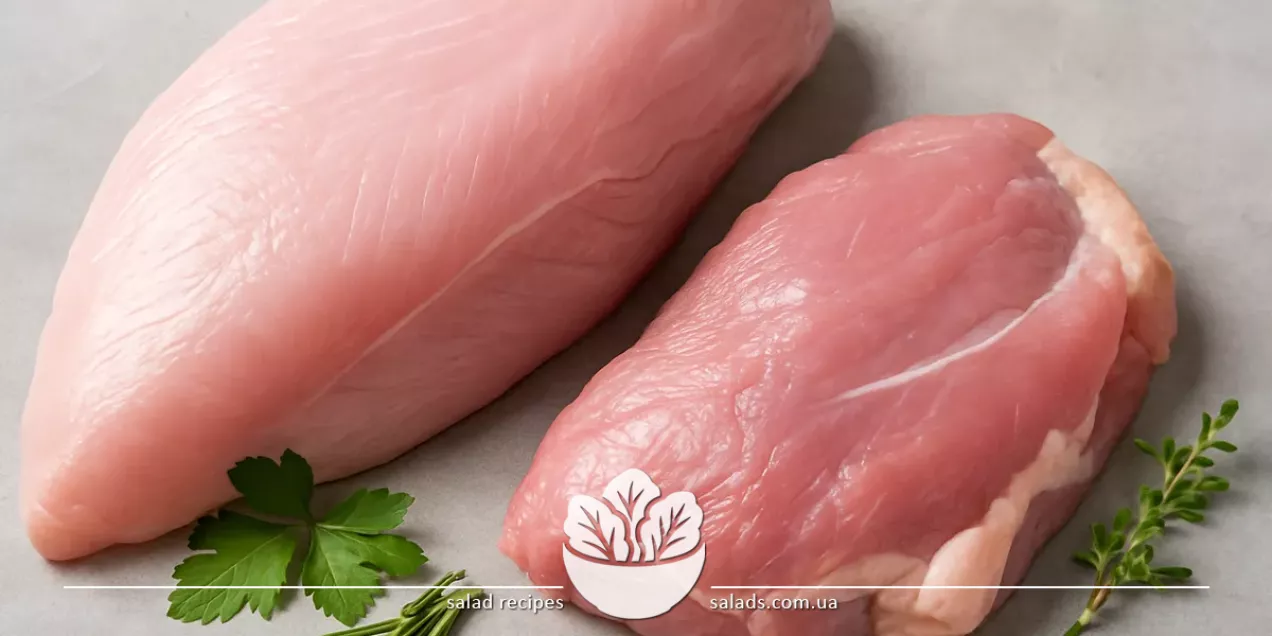Turkey

Turkey is the meat of a large bird valued for its leanness, tenderness, and nutritional properties. It is rich in protein, vitamins, and minerals, while being low in fat. Turkey is used in a wide variety of dishes – from soups to festive main courses, as well as in salads and appetizers. Due to its versatility, turkey is a frequent part of healthy diets and is often present in meal plans. Learn more about other types of poultry in the poultry section.
Salad Recipes with Turkey
Turkey is lean, tender, and nutritious meat that is perfect for making both everyday and festive salads. Thanks to its mild taste, it pairs well with a wide range of ingredients. One of the most popular options is a salad with boiled turkey, cheese, pineapple, and mayonnaise – a light yet hearty dish with a pleasant sweet note. Turkey is also often added to salads with Chinese cabbage, corn, croutons, and garlic dressing – this version resembles a “Caesar” salad but has a lighter base. For healthy diets, a salad with boiled or baked turkey, fresh cucumber, cherry tomatoes, spinach, and yogurt dressing is ideal. A festive option is a warm salad with fried turkey, mushrooms, buckwheat crepes, or grilled vegetables. Turkey also goes well with apples, celery, cranberries, and nuts in salads with American flair. It’s a universal ingredient that adds nutritional value, lightness, and pleasant flavor to any salad.
Classic Recipes with Turkey
Turkey is a versatile ingredient for many classic and modern recipes. It is excellent for roasting, frying, and stewing. A classic dish is roasted turkey fillet with aromatic herbs, served with fresh vegetables or potatoes. In many families, festive turkey is traditionally cooked stuffed with vegetables, mushrooms, or grains, making the dish hearty and aromatic. Turkey is a popular ingredient in salads – from simple versions with boiled meat and greens to more complex ones with cheese, vegetables, and sauces. It is often combined with chicken eggs or smoked pork, such as bacon, to add richness. In stewed dishes, turkey is prepared with vegetables such as sweet peppers and onions or served with sauces that enhance the meat’s tenderness. Turkey is also common in soups and stews, where its soft meat blends harmoniously with other ingredients, including salmon in more elaborate recipes. This diversity makes turkey a desirable product in any cuisine.
Turkey in World Cuisines
Turkey plays an important role in the culinary traditions of many countries. In North America, especially the USA and Canada, roasted turkey is a must for celebrations, particularly Thanksgiving and Christmas. There, it is often stuffed with grains, vegetables, nuts, or dried fruits, prepared with various sauces, and served with potato and vegetable side dishes. In European cuisines, turkey is roasted or stewed using local spices and herbs such as rosemary, thyme, and garlic. In Italy, turkey may be used as a filling for pasta or roulades, while in Mediterranean countries, it is prepared with olive oil, lemon, and greens. In some Asian countries, turkey is used in soups and stews, combined with vegetables and spicy sauces. It adapts well to different seasonings and cooking techniques, making it popular across diverse gastronomic cultures. The versatility and nutritional value of turkey make it a staple on every continent.
Choosing Quality Turkey
When choosing turkey, it’s important to pay attention to the freshness and appearance of the meat. Fresh meat should be light pink in color, firm in texture, and free from unpleasant odors. Avoid products with spots, slime, or overly dark areas. For frozen meat, make sure there are no ice crystals or signs of refreezing, which can affect the quality and flavor. It is best to purchase turkey from trusted stores or markets that follow hygiene standards. Check the packaging – it should be intact, sealed, and display clear production and expiration dates. Turkey should be chilled, as long exposure to room temperature quickly reduces its quality. If possible, choose meat that is labeled or certified for quality and origin. Choosing the right turkey ensures a tasty, healthy, and safe meal.
Preparing and Cooking Turkey
Before cooking, turkey should be rinsed, patted dry, and, if needed, trimmed of membranes or fat. For more even cooking, large pieces are sometimes cut or tenderized. Marinating is a popular way to enhance juiciness and add extra flavor. Marinades based on yogurt, lemon juice, spices, and herbs are commonly used. Turkey can be roasted in the oven, fried in a pan, stewed with vegetables, or boiled. Roasted turkey turns out juicy, especially if covered with foil during cooking or basted with its juices. For stewing, the meat is cut into portions and cooked with vegetables, spices, and sauces. In salads and cold dishes, turkey is served boiled or baked, finely chopped. Turkey meat is used to make patties, roulades, pâtés, and stuffing with additional ingredients such as eggs, bread, and vegetables. Turkey’s flexibility and neutral flavor make it popular for a wide variety of culinary experiments.
Storing and Reusing Turkey
Raw turkey meat should be stored in the refrigerator at 0-4 °C for no more than 1-2 days. For longer storage, it can be frozen – at -18 °C, it retains quality for up to 6 months. Avoid refreezing, which negatively affects texture and flavor. When storing ready-made turkey dishes, ensure the packaging is airtight and consume within 2-3 days. Leftover turkey is convenient for use in salads, soups, casseroles, or fillings. It pairs well with vegetables, grains, and sauces, making it a versatile ingredient for repurposing meals. Proper storage and reuse help reduce food waste and maintain meal variety without extra time or effort.